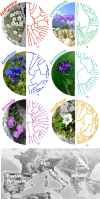Tempo and drivers of plant diversification in the European mountain system
- PMID: 35585056
- PMCID: PMC9117672
- DOI: 10.1038/s41467-022-30394-5
Tempo and drivers of plant diversification in the European mountain system
Abstract
There is still limited consensus on the evolutionary history of species-rich temperate alpine floras due to a lack of comparable and high-quality phylogenetic data covering multiple plant lineages. Here we reconstructed when and how European alpine plant lineages diversified, i.e., the tempo and drivers of speciation events. We performed full-plastome phylogenomics and used multi-clade comparative models applied to six representative angiosperm lineages that have diversified in European mountains (212 sampled species, 251 ingroup species total). Diversification rates remained surprisingly steady for most clades, even during the Pleistocene, with speciation events being mostly driven by geographic divergence and bedrock shifts. Interestingly, we inferred asymmetrical historical migration rates from siliceous to calcareous bedrocks, and from higher to lower elevations, likely due to repeated shrinkage and expansion of high elevation habitats during the Pleistocene. This may have buffered climate-related extinctions, but prevented speciation along elevation gradients as often documented for tropical alpine floras.
© 2022. The Author(s).
Conflict of interest statement
The authors declare no competing interests.
Figures




References
-
- Antonelli A, et al. Geological and climatic influences on mountain biodiversity. Nat. Geosci. 2018;11:718–725. doi: 10.1038/s41561-018-0236-z. - DOI
Publication types
MeSH terms
LinkOut - more resources
Full Text Sources

